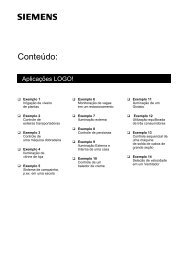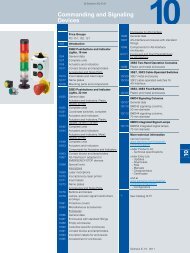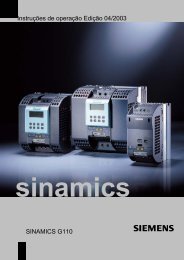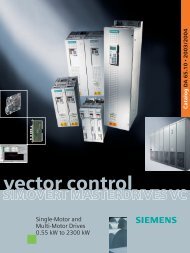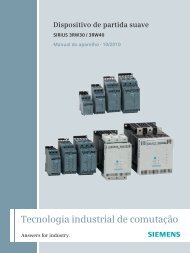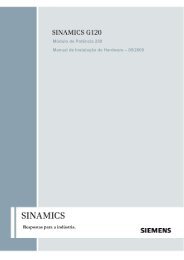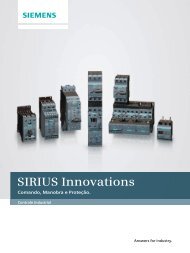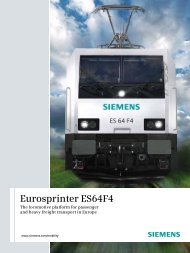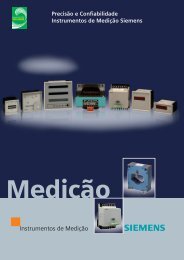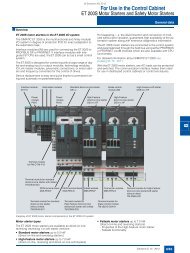SIMOVERT MV Medium-Voltage Drives 660 kVA to 9100 ... - Industry
SIMOVERT MV Medium-Voltage Drives 660 kVA to 9100 ... - Industry
SIMOVERT MV Medium-Voltage Drives 660 kVA to 9100 ... - Industry
Create successful ePaper yourself
Turn your PDF publications into a flip-book with our unique Google optimized e-Paper software.
<strong>SIMOVERT</strong> <strong>MV</strong>Engineering informationEMC – Electromagnetic compatibilityUse and operation (continued)Single-sided groundingof the cable screensFor analog signal cables, whichconduct low signal levels (mV ormA), the cable screen is connectedon one side <strong>to</strong> thescreen rail in the cabinet (thisavoids ground loops and inductive/parasiticinterference at theline frequency). The open end ofthe screen can then be connected<strong>to</strong> the housing througha noise suppression capaci<strong>to</strong>r(e.g. 0.1 mF 100 V MKT).Routing cables¦ All of the signal cables mustbe screened.¦ The signal cables must beseparated in accordancewith signal groups.¦ Cables with digital signalsmay not be routed <strong>to</strong>getherunscreened next <strong>to</strong> cableswith analog signals. If sharedsignal cables are used, theindividual signals must bemutually screened.¦ Cables must be routed asclose as possible <strong>to</strong>grounded sheet steel panels.This reduces noise signalswhich are inductively coupledin.¦ Unnecessary cable lengthsshould be avoided since theyresult in additional couplingcapacitances and couplinginductances.¦ There must be a minimumclearance of > 20 cmbetween signal cables andpower cables below 500 VAC; there must be a clearance> 30 cm <strong>to</strong> powercables above 1 kV AC.¦ If possible, power cablesshould cross over oneanother at an angle of 90°.Undampened contac<strong>to</strong>rsIt is not permissible <strong>to</strong> use undampenedcontac<strong>to</strong>rs in thedrive converter cabinets. Thus,all of the contac<strong>to</strong>rs mounted inthe fac<strong>to</strong>ry are dampened. Ifundampened contac<strong>to</strong>rs areused in an adjacent cabinet,then the cabinets must be partitionedoff using side panels.Contac<strong>to</strong>r coils which are connected<strong>to</strong> the same supply networkas the drive converterauxiliary power supply, or locatedclose <strong>to</strong> the drive converter,must be provided with surgelimiters (RC elements, varis<strong>to</strong>rs).Additional cablingAny additional cabling in thecabinet should be kept as shortas possible, and should berouted close <strong>to</strong> the cabinethousing or mounting panels.Unscreened cables associatedwith the same circuit (outgoingand incoming conduc<strong>to</strong>r)should be twisted.System componentsCircuit-breakerThe circuit-breaker, connectedat the primary side of the incomingtransformer, is part ofthe drive converter safety system.If a fault was <strong>to</strong> occur withinthe drive converter, then theenergy discharged at the faultlocation must be limited. This isrealized as a result of the inductanceof the incoming transformer(V K min = 6%), which limitsthe rate-of-rise and thecircuit-breaker which trips asquickly as possible.In order <strong>to</strong> guarantee theseconditions, the circuit-breakermust have the following features:¦ The complete release time ofthe circuit-breaker may notexceed 80 ms.¦ The circuit-breaker must beequipped with an undervoltagerelease. The undervoltagerelease (undervoltagecoil) is controlled through therelease circuit, in<strong>to</strong> whichalso the “undervoltagerelease” output of the driveconverter is <strong>to</strong> be integrated.The power is supplied by theauxiliary voltage (safe supply)of the switching unit.Note:In drive converters, the undervoltagerelease is usuallynot supplied by voltage transformersconnected <strong>to</strong> themain grid; so undervoltage inthe main grid will not lead <strong>to</strong>turn-off by the switching unit/ voltage transformer.¦ Additional delay times in thecontrol of the circuit-breakermust be avoided. All commandsfrom the drive converter<strong>to</strong> the circuit-breakermust act directly without anyrelays involved.¦ There must be one checkbacksignal for the ON statusand for the OFF status of thecircuit-breaker either. Thecheckback signals must notbe delayed, i.e. don’t usecoupling relays.¦ The circuit-breaker musthave an overcurrent-timeprotection.¦ The circuit-breaker must byno means be switched onexternally neither by electricalnor by mechanical control. Amechanical interlock of themanual ON command at thecircuit-breaker prevents thedrive converter from beingdestroyed due <strong>to</strong> uncoordinatedpower-on.¦ To prevent the drive converterfrom switching offshowing sequential signalswhich cannot be assigned ifthe circuit-breaker is trippedexternally, the drive convertermust be powered off bymeans of a leading contactbefore the main circuitbreakercontacts open. Inaddition, a relating signal(“circuit-breaker external tripping”)is generated/emitted.6Siemens DA 63 · 2004 6/15



